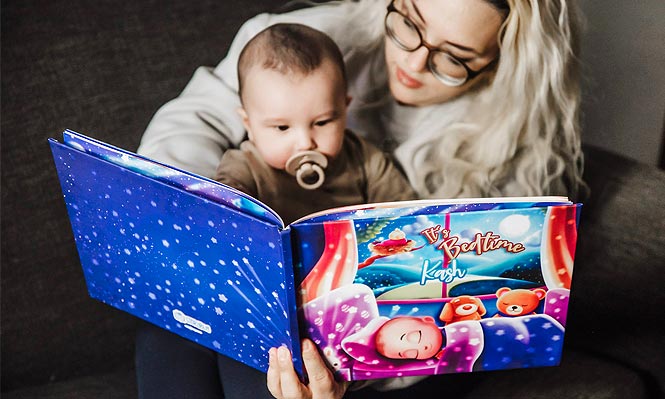Join the Story Bug club
Be first to know about new stories and offers
Bedtime Stories: Tips for Making Reading a Nightly Routine

We all know the importance of reading to our little ones, but did you know that establishing a bedtime routine can make a world of difference? Not only does it create a sense of consistency and relaxation, but it also sets the stage for a lifelong love of reading. So, let's dive into some tips for making bedtime stories a cherished part of your toddler's nightly routine.
When it comes to reading to newborns and infants, you might wonder if it's worth the effort since they can't understand the words. But let me assure you, it's absolutely worth it. Not only does reading to your little one create a valuable bonding experience, but it also sets the foundation for a lifelong love of books.
As you snuggle up close and read aloud, the soothing sound of your voice can help your baby relax and feel secure. While they may not understand the words at such a young age, the rhythmic patterns and gentle melodies of your voice can have a calming effect, making bedtime stories an essential part of their sleep routine.

As your baby grows older and starts to engage more with the world around them, they'll begin to take an interest in the pictures and illustrations in the books you read. This is an exciting time as their curiosity and imagination start to develop. They may even begin to anticipate certain parts of the story or show a preference for specific books.
To make the most out of reading to newborns and infants, it's important to establish a routine from the very beginning. By incorporating bedtime stories into your child's daily ritual, you create a sense of consistency and comfort. This routine not only prepares them for sleep but also strengthens the bond between you and your little one.
When it comes to selecting the perfect bedtime story for your little one, the key is to find a book that captivates their interest.
For younger children, books with rhyme and repetition are great options. These types of stories engage their developing language skills and make reading both fun and interactive. On the other hand, older children can be involved in choosing their own books. Let them explore different genres and styles to keep the reading experience exciting.
Don't be afraid to explore different types of stories together. It's a chance to introduce your child to new ideas, cultures, and perspectives. Whether it's a fairytale, an adventure, a non-fiction book, or something completely different, exposing your child to a variety of genres can ignite their imagination and expand their horizons.
"The more that you read, the more things you will know. The more that you learn, the more places you'll go." - Dr. Seuss
Pay attention to what your child shows interest in – whether it's animals, sports, or fantasy worlds. Look for books that align with those interests. When children are engaged with the subject matter, they'll be more eager to read and learn.
By choosing the right bedtime story, you can create a magical reading experience that your child will look forward to every night.
Once you've chosen a book, it's time to create a cozy and comfortable environment for reading with your little one. This is an important step in making bedtime stories a soothing and enjoyable experience for both of you.
First, snuggle up close together. Find a cozy spot where you can cuddle up and get comfortable. Whether it's on the couch, in their bed, or in a cozy chair, the key is to create a space where you can both relax and focus on the story.
Let your child hold the book or turn the pages if they're old enough. This not only gives them a sense of independence but also allows them to actively participate in the reading experience. It's a small gesture that can make them feel involved and engaged.
This is also a wonderful opportunity to have quality one-on-one time with your child. Use this time to encourage them to express their thoughts and feelings about the story. Ask open-ended questions and listen attentively to their responses. This not only strengthens your bond but also helps foster their language and communication skills.
Bedtime stories don't have to be quiet and serious. We believe that reading should be a fun and engaging experience for both you and your child. By using silly voices, actions, and even choosing funny or entertaining stories, you can make storytime a joyous occasion.

Don't be afraid to be animated and expressive while reading. Use different voices for each character and act out the story with enthusiasm. This will not only capture your child's attention but also create a memorable and enjoyable experience.
Reading before bed offers a multitude of benefits for your child's development. Not only does it enhance their language and literacy skills, but it also contributes to their emotional well-being. Shared reading creates a strong bond between parent and child, providing a platform for meaningful conversations and connections. Additionally, engaging in regular reading sessions fosters empathy, boosts creativity, and instills a lifelong love of learning.
When we read bedtime stories to our kids, we expose them to a wide range of vocabulary and sentence structures, helping to expand their language skills. Through the magic of storytelling, children are exposed to new words and concepts, enhancing their ability to communicate effectively.
"Bedtime reading allows children to explore different emotions and situations through the characters and events in the story. It opens up opportunities for discussions about feelings, problem-solving, and empathy, nurturing emotional intelligence in children,"
Bedtime reading also stimulates the imagination and encourages creative thinking in children. As they immerse themselves in captivating stories and vivid illustrations, their minds are transported to new worlds, fostering curiosity and imagination. This imaginative play contributes to cognitive development and nurtures a child's ability to think critically and problem-solve.
A regular bedtime reading routine instills a love of learning in children from an early age. By associating reading with comfort and coziness, children develop a positive attitude towards books and education. This positive association carries through their educational journey, making learning more enjoyable and motivating.
If your child is reluctant to engage with bedtime stories, there are a few strategies you can try.
By using these strategies, you can make bedtime stories more engaging and enjoyable for even the most reluctant readers.
Bedtime reading isn't just about finishing the book. It's an opportunity to connect, talk, and learn about each other. Be open to extended conversations, even if they deviate from the story. Encourage your child to share their thoughts and feelings, fostering communication and a deeper understanding of the world around them.
Extending the storytime experience beyond the pages of the book offers several benefits for both parent and child. By engaging in conversation, you create a safe and intimate space where your child can express themselves and share their unique perspective. These conversations can:
As parents, we can take advantage of these extended conversations to impart important lessons and values. For example, if the story features a moral dilemma or a character facing a challenge, we can use this opportunity to discuss empathy, problem-solving, or resilience. By weaving these discussions into our storytime routine, we foster a deeper understanding of complex emotions and principles.
Consistency is key when it comes to the bedtime routine. Try to establish a set bedtime and follow the same steps every night. This predictability helps your toddler feel secure and know what to expect. Whether it's bathing, brushing teeth, reading a bedtime story, or cuddling, maintaining a consistent routine creates stability and a sense of calm before sleep.
To ensure a successful bedtime routine, consider the following tips:
Bedtime stories for toddlers are not only a cherished part of their nightly routine, but they also play a crucial role in their overall development. By establishing a regular reading habit, choosing engaging books, and creating a cozy environment, you can create lasting memories and promote a love of reading in your child.
Through the simple act of reading together, you are fostering your child's language skills and imagination. Bedtime stories provide an opportunity for conversation, connection, and the exploration of new ideas. By engaging in toddler storytime, you are laying the foundation for a lifelong love of reading.
Yes, reading to newborns and infants is a valuable bonding experience. The sound of your voice and the closeness of snuggling up while reading can help them relax. As they grow older, they will start to engage with the pictures and develop a love for books.
The best book to read with your child is the one they enjoy the most. Whether it's an interactive picture book or a themed story, the key is to find something that captivates their interest. Books with rhyme and repetition are great for younger children, while older children can be involved in choosing their own books.
Make reading fun and engaging by using silly voices, actions, and even choosing funny or entertaining stories. Don't be afraid to be animated and expressive while reading. The goal is to make storytime enjoyable for both you and your child, creating a positive association with reading.
It's normal for bedtime routines to be more relaxed during certain times, such as vacations or busy weeks. However, it's still important to incorporate reading into the routine. Bedtime stories not only help with sleep but also provide a chance to bond and practice reading skills. Try to maintain consistency in your routine, even during these times, to provide a sense of stability for your child.
Reading before bed has numerous benefits for your child's development. It supports their language and literacy skills, as well as their emotional development. Shared reading also strengthens the parent-child bond and provides an opportunity for conversation and connection. Reading regularly with your child helps foster empathy, creativity, and a love of learning.
 Bedtime Stories: Tips for..
Are bedtime stories beneficial for toddler sleep routines?
Jan 8, 2024
Bedtime Stories: Tips for..
Are bedtime stories beneficial for toddler sleep routines?
Jan 8, 2024
 Girls Books to Inspire and Empower..
For young girls, seeing themselves represented as the protagonist in a story can have an enormous impact.
Jan 9, 2023
Girls Books to Inspire and Empower..
For young girls, seeing themselves represented as the protagonist in a story can have an enormous impact.
Jan 9, 2023
 Reading as a Family..
Picture this: cuddling up with your little one and opening a book that is specially made for them.
Jan 17, 2023
Reading as a Family..
Picture this: cuddling up with your little one and opening a book that is specially made for them.
Jan 17, 2023